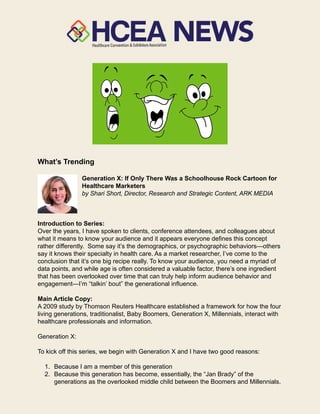
Generation X Healthcare Marketing
- 1. What’s Trending Generation X: If Only There Was a Schoolhouse Rock Cartoon for Healthcare Marketers by Shari Short, Director, Research and Strategic Content, ARK MEDIA Introduction to Series: Over the years, I have spoken to clients, conference attendees, and colleagues about what it means to know your audience and it appears everyone defines this concept rather differently. Some say it’s the demographics, or psychographic behaviors—others say it knows their specialty in health care. As a market researcher, I’ve come to the conclusion that it’s one big recipe really. To know your audience, you need a myriad of data points, and while age is often considered a valuable factor, there’s one ingredient that has been overlooked over time that can truly help inform audience behavior and engagement—I’m “talkin’ bout” the generational influence. Main Article Copy: A 2009 study by Thomson Reuters Healthcare established a framework for how the four living generations, traditionalist, Baby Boomers, Generation X, Millennials, interact with healthcare professionals and information. Generation X: To kick off this series, we begin with Generation X and I have two good reasons: 1. Because I am a member of this generation 2. Because this generation has become, essentially, the “Jan Brady” of the generations as the overlooked middle child between the Boomers and Millennials. WHAT’S TRENDING
- 2. According to the Thomson study, the overarching arc for this generation is “Educate Me”. Ranging from 1960-1980, the nation’s first latchkey kids thrived off their independence and individuality. They were encouraged to nurture this attitude with messages like “Free to Be You and Me” and non-traditional learning avenues such as Sesame Street and Schoolhouse Rock. Although empowered, members of Generation X tend to be more skeptical than their Boomer predecessors and discerning in their consumer choices and expect valid data to help inform their decision-making processes. How can Exhibitors and Planners utilize this knowledge to best communicate to Generation X? • Evidence Based Information. Do you remember that scene in Jerry Maguire when Cuba Gooding Jr.’s character kept saying “Show me the money!” Of course you do, he won an Oscar for that film. Generation X’ers want you to show them the numbers. Outcome measures are important to this group, as evidenced in how funding stream requirements changed as this cohort moved up the ranks in decision-making. HCPs who visit the booth come with expectations that marketers can back up their claims and are resourceful enough to google statistics right there in the booth, in order to ask more questions. For Generation X, show them the data and show them the implications of this data to influence attitude or behavior change. • Time is Currency. While the Boomers introduced nonprofit organizations to the workforce, Generation X initiated the initiative for Work/Life Balance. This generation’s definition of career investment is vastly different from its predecessor. The HCPs attending your events view their career as part of their identity but, only part. They seek opportunities that will advance their career as long as the time spent away from other areas of their life are clearly worth the time investment. For many event planners, this means using data to support why they will benefit from attending the conference at all, let alone booth participation. • Staying Power. If you’ll indulge me in one more pop culture movie reference, like Glenn Close said in Fatal Attraction, they are “not going to be ignored” as a fundamental player in their respective fields or consumer-driven advances. Media pays a significant amount of attention to the Millennials and how to court them. But what about us? We’re next in line for the promotions, we’re funding the startups and venture capital projects, and we’re seeing the fruit of our own labor as our ideas finally come to life in all areas of research and technology. Generation X is still in the game. To summarize, if marketers can help establish conferences and congresses as places where data comes to life, time is well spent and their input is appreciated, the loyalty will follow as well as ambassadorship to those younger Millennials. Maccra Cken, L., Pickens, G., Wells, M. Matching the Market: Using Generational Insights to Attract and Retain Consumers. Tomson Reuters. 2009.
